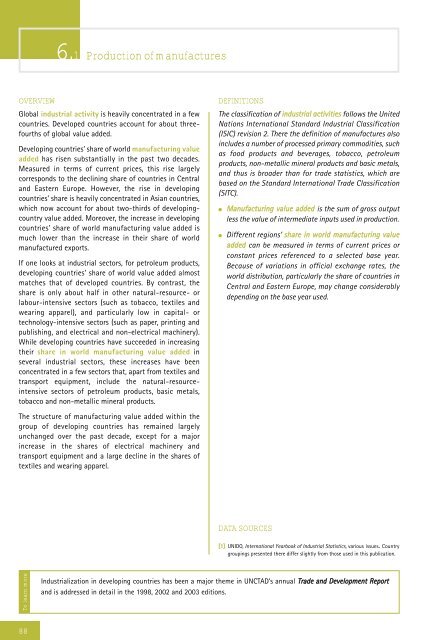Development and Globalization: - Unctad
Development and Globalization: - Unctad
Development and Globalization: - Unctad
You also want an ePaper? Increase the reach of your titles
YUMPU automatically turns print PDFs into web optimized ePapers that Google loves.
OVERVIEW DEFINITIONS<br />
Global industrial activity is heavily concentrated in a few<br />
countries. Developed countries account for about threefourths<br />
of global value added.<br />
Developing countries’ share of world manufacturing value<br />
added has risen substantially in the past two decades.<br />
Measured in terms of current prices, this rise largely<br />
corresponds to the declining share of countries in Central<br />
<strong>and</strong> Eastern Europe. However, the rise in developing<br />
countries’ share is heavily concentrated in Asian countries,<br />
which now account for about two-thirds of developingcountry<br />
value added. Moreover, the increase in developing<br />
countries’ share of world manufacturing value added is<br />
much lower than the increase in their share of world<br />
manufactured exports.<br />
If one looks at industrial sectors, for petroleum products,<br />
developing countries’ share of world value added almost<br />
matches that of developed countries. By contrast, the<br />
share is only about half in other natural-resource- or<br />
labour-intensive sectors (such as tobacco, textiles <strong>and</strong><br />
wearing apparel), <strong>and</strong> particularly low in capital- or<br />
technology-intensive sectors (such as paper, printing <strong>and</strong><br />
publishing, <strong>and</strong> electrical <strong>and</strong> non-electrical machinery).<br />
While developing countries have succeeded in increasing<br />
their share in world manufacturing value added in<br />
several industrial sectors, these increases have been<br />
concentrated in a few sectors that, apart from textiles <strong>and</strong><br />
transport equipment, include the natural-resourceintensive<br />
sectors of petroleum products, basic metals,<br />
tobacco <strong>and</strong> non-metallic mineral products.<br />
The structure of manufacturing value added within the<br />
group of developing countries has remained largely<br />
unchanged over the past decade, except for a major<br />
increase in the shares of electrical machinery <strong>and</strong><br />
transport equipment <strong>and</strong> a large decline in the shares of<br />
textiles <strong>and</strong> wearing apparel.<br />
To learn more<br />
88<br />
6.1 Production of manufactures<br />
The classification of industrial activities follows the United<br />
Nations International St<strong>and</strong>ard Industrial Classification<br />
(ISIC) revision 2. There the definition of manufactures also<br />
includes a number of processed primary commodities, such<br />
as food products <strong>and</strong> beverages, tobacco, petroleum<br />
products, non-metallic mineral products <strong>and</strong> basic metals,<br />
<strong>and</strong> thus is broader than for trade statistics, which are<br />
based on the St<strong>and</strong>ard International Trade Classification<br />
(SITC).<br />
● MMaannuuffaaccttuurriinngg vvaalluuee aaddddeedd is the sum of gross output<br />
less the value of intermediate inputs used in production.<br />
● Different regions’ sshhaarree iinn wwoorrlldd mmaannuuffaaccttuurriinngg vvaalluuee<br />
aaddddeedd can be measured in terms of current prices or<br />
constant prices referenced to a selected base year.<br />
Because of variations in official exchange rates, the<br />
world distribution, particularly the share of countries in<br />
Central <strong>and</strong> Eastern Europe, may change considerably<br />
depending on the base year used.<br />
DATA SOURCES<br />
[1] UNIDO, International Yearbook of Industrial Statistics, various issues. Country<br />
groupings presented there differ slightly from those used in this publication.<br />
Industrialization in developing countries has been a major theme in UNCTAD’s annual TTrraaddee aanndd DDeevveellooppmmeenntt RReeppoorrtt<br />
<strong>and</strong> is addressed in detail in the 1998, 2002 <strong>and</strong> 2003 editions.

















